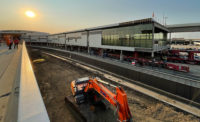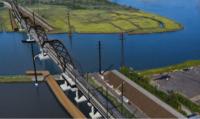Anew 12-hammer pile-driving device, called the DodecaKong, has begun driving 30-meter-dia steel-pipe piles for an artificial island that will host a new airport in Sanya, China. Built by American Piledriving Equipment (APE), the hammer assembly tops the previous world record of driving 22-m-dia piles, performed by the eight-hammer OctaKong configuration for the $10-billion Hong Kong-Macau link.
The 14,400-horsepower DodecaKong began driving the first of more than 300 piles in January for the two-year, $15-billion airport project, which includes five runways and will handle 20 million passengers a year. The current airport was designed for 1.5 million annual passengers but is burdened with 13 million, due to the area’s increasing role as a tourist attraction, notes David White, APE China managing director.
Averaging 700 tonnes, the 43-m-long piles are driven as deep as 15 m into the South China sea to create land for the New Sanya International Airport. First Harbor Engineering Co. Ltd. had purchased the original OctaKong and bought two sets of DodecaKongs—one for the new 24-kilometer airport and one for the ShenZhen-ZhongShan bridge, which requires 28-m-dia piles. Another contractor, China Construction Number 6 Engineering Co., also bought a DodecaKong to drive ten 30-m-dia piles for their portion of the airport project. Neither contractor was available for comment.
“We redesigned the [OctaKong] structures and lifting geometries over two or three weeks in September,” says Dan Collins, APE president. “At least 250 piles will be driven for just half the island.” Chinese officials are still considering other options for the other half of the island, he says, adding, “Design and constructibility are a concern. These large-diameter piles are still relatively new technology relative to the concrete alternative, which you know you can do. On phase one, they decided to install 20 of these piles. You drive a pile, fill it with sand and drive the wingwalls—40-foot intermediate pieces of steel that connect the big cylinders.”
At full power, the DodecaKong delivers nearly 4,000 gallons of oil a minute, producing 7,200 tons of drive force, says White. An advanced control system keeps all components in perfect synchronization.
The tight, two-year deadline for the project, plus the harsh ocean environment, spurred the request for the massive piles, says White. “There are very heavy tides and severe weather. The lateral loads are the bigger concern in constructing the island. The engineers wanted to drive as big of a diameter pile as possible with as large a crane as possible. The smaller the crane and pile, the more difficult it is to position the piles in the correct spot.”
Strong Winds
The wind can blow so strong that a service technician got stuck inside a ship.
“It took three people just to muscle the door open so he could get out,” says White. “On another day, while our hammer was hanging more than 20 feet above the water on calm waves, a rogue set of 15-foot swell waves hit our ship and dunked the hammer 10 feet into the water, then it sprung up more than 30 feet in the air.”
One pile takes about 24 minutes to drive. “They’re about as tall as they are wide in diameter,” Collins says. “They’re installed into the seabed about a third or half of the total length. The pile hammer could drive as fast as you can lower the crane hook, but you don’t want to do it that fast. You go down a little at a time, driving straight and controlled.”







Post a comment to this article
Report Abusive Comment